Initially conceived as MIUI 15, HyperOS unifies a diverse range of Xiaomi products, creating a seamless ecosystem that goes beyond the traditional boundaries of mobile devices. While the HyperOS update is so close to coming to the global market, here you will learn everything you need to know before installing the HyperOS update on your phone. Actually, there isn’t much you need to know about HyperOS. It is exactly the same as MIUI but there are some fundamental changes and these may affect you.
HyperOS is actually MIUI 15
Contrary to expectations of a radical overhaul, HyperOS maintains a visual continuity with its predecessor, MIUI 14. While the user interface remains largely unchanged, subtle tweaks in animations and the strategic integration of blur effects impart an Apple-like aesthetic. Notably, these visual enhancements are optimized primarily for flagship devices, ensuring a cohesive and visually pleasing experience for users with high-end Xiaomi hardware.
Additionally, in the first released version of HyperOS, there was no HyperOS code anywhere except the installation screen. MIUI 15 codes were also visible in the system. In fact, it was released as MIUI 15 in the first leaked HyperOS beta version.
Bootloader Lock Restrictions
An essential consideration for users contemplating the transition to HyperOS is the bootloader status. Devices with an unlocked bootloader won’t seamlessly receive updates, a deliberate strategy to mitigate potential software complications. Users must ensure their bootloader is re-locked before engaging in the update process. However, Xiaomi continues to provide flexibility through manual updates via a computer interface.
117 Devices and Counting: HyperOS Widespread Rollout
The scope of HyperOS is expansive, with the HyperOS update set to roll out to an impressive 117 Xiaomi, Redmi, and POCO devices. This inclusive approach underscores Xiaomi’s commitment to providing a unified experience across various price points and device categories.
Conclusion: HyperOS, Shaping Xiaomi’s Ecosystem
In conclusion, HyperOS represents more than just a numerical upgrade; it’s a strategic move by Xiaomi to consolidate its ecosystem. Despite the absence of a radical visual overhaul, HyperOS promises a more streamlined experience, harmonizing user interfaces across a myriad of devices. As users prepare for the inevitable shift to MIUI 15 in the form of HyperOS, understanding the bootloader nuances becomes paramount. Xiaomi’s commitment to shaping a unified operating system landscape is evident, and users can expect ongoing refinements and advancements as the HyperOS journey unfolds.






